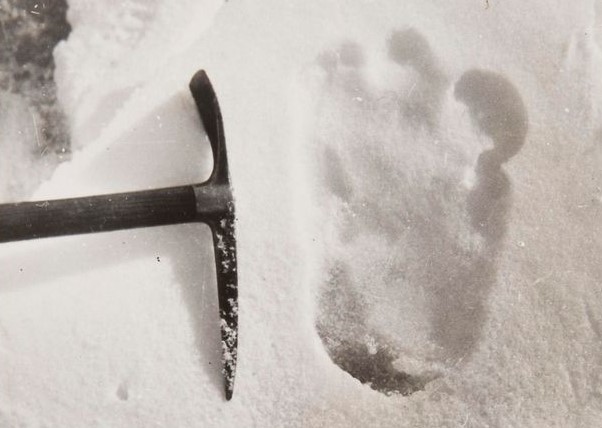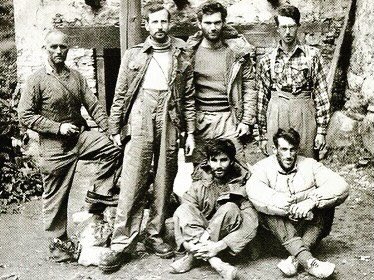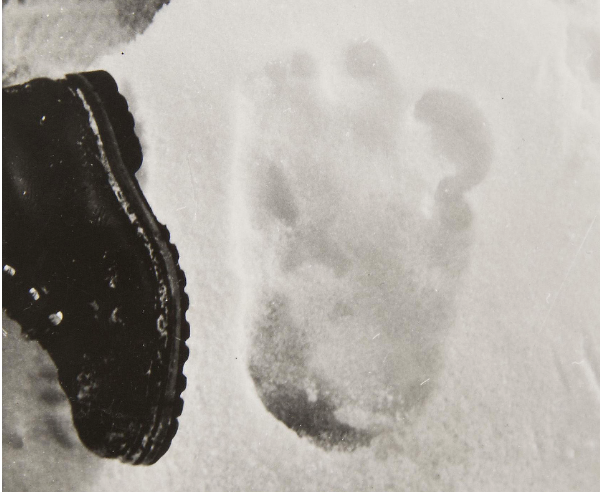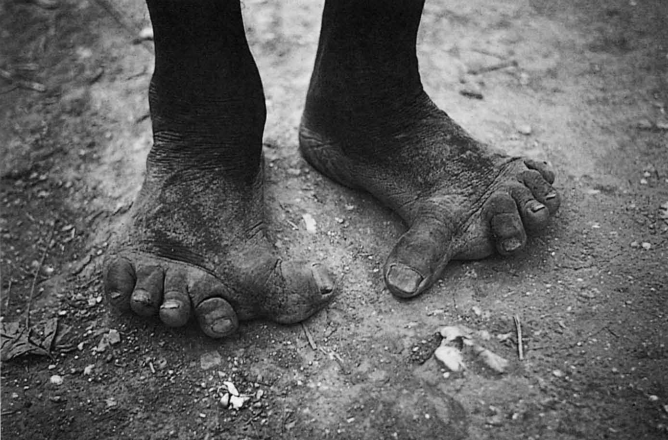The Yeti Footprints of Mount Everest, as Photographed by Eric Shipton

Whether you know them as Yetis or Abominable Snowmen, these ape-like creatures are the undeniable kings of snow dwelling cryptids. Similar to the North American Bigfoot, the Yeti is said to be a solitary creature who roams the snowy mountains of the Himalayas. While generally considered part of Sherpa (a Tibetan ethnic group’s) folklore, mountaineers in the region have recorded numerous ‘sightings’ throughout the past two centuries sparking debates over whether or not the illusive creature actually exists.
When Westerners began climbing the Himalayan mountains during the early twentieth-century reports of alleged Yeti sightings soared. These sightings peaked in the 1950s when one of the most infamous pieces of Yeti evidence was brought down from the barren glaciers of Mount Everest.
Footprints in the Snow

In the autumn of 1951 (when Everest wasn’t a crowded tourist destination), English mountaineers Eric Shipton and Dr Michael Ward were part of an expedition to survey possible routes to reach the summit of Everest from Nepal. Led by Shipton, findings from this expedition would lead to the first successful recorded ascent of Mount Everest by Edmund Hillary and Tenzing Norgay two years later in 1953. Not only was it an important expedition for mapping the route up the highest mountain in the world, the 1951 expedition also kickstarted the return to climbing after expeditions were put on hold during the Second World War.
But the 1951 expedition was also known for something else entirely.
At around 15-16,000 feet, Shipton and Ward stumbled upon a strange sight — a series of peculiar footprints in the snow of the Menlung Basin. Since the mountaineers had no tools available for measuring the footprints, they used what they had on hand – an ice pick, a backpack, and Michael Ward’s left boot. Shipton snapped a series of photographs as the duo closely examined their findings. In a photo of the boot next to one footprint (below), it’s clear that the print was considerably wider than a typical human foot — nearly two times that, according to Ward. The toes of the footprint were grotesque in shape and the big toe appeared lower and larger than expected from a human. And even if it was human, how had they managed to walk through the snow in freezing temperatures without any foot protection?

Puzzled, they followed the footprints down the glacier for about a mile until they stopped to make a camp for the night. They were joined a few days later by teammates W. H. Murray and Tom Bourdillon who also examined the curious footprints. Bourdillon’s diary admits that by the time he reached the prints they had become somewhat distorted by the sun, but he still acknowledged them as a surprising and unexplained addition to their expedition.
When the expedition team returned home to Britain, Shipton’s strange photographs began making the rounds. It was an exciting time for cryptozoologists, monster hunters, and mountaineers because, for many, the photographs meant only one thing: proof the mythological Yeti roamed the Himalayas.
Following their publication, numerous expeditions commenced in the Himalayas and Central Asia in an attempt to uncover whether or not the creature that made the footprints in Shipton’s photographs actually existed. However, not a single shred of evidence was found to prove the existence of the Yeti. This led to some accusing Shipton of staging a hoax.
Others in their party who had seen the footprints later vouched for the legitimacy of Shipton’s photographs, including Bourdillon who wrote his account in a letter to Michael John Davies during the 1950s.

The letter reads:
Dear Mick. Here are the footprint photos: sorry for the delay. We came across them on a high pass on the Nepal-Tibet watershed during the 1951 Everest expedition. They seemed to have come over a secondary pass at about 19,500 ft, down to 19,000 ft where we first saw them, and then went on down the glacier. We followed them for the better part of a mile. What it is, I don’t know, but I am quite clear that it is no animal known to live in the Himalaya, & that it is big. Compare the depths to which it & Mike Ward (no featherweight) have broken into the snow. Yours, Tom Bourdillon
Letter from Tom Bourdillon to Michael John Davies, c. 1950s
Even Yeti-naysayers could admit the photos were indeed strange. If the footprints were real, and there wasn’t much reason to believe Shipton and Ward would be lying, a legendary monster was at the bottom of the list of reasonable explanations. And according to footprint co-founder Ward, the Yeti tracks likely had a much more natural source.
Michael Ward’s Theory
Utilising his medical background, Ward proposed a theory of the footprints’ origin within the context of the Everest region in his article “The Yeti Footprints: Myth and Reality” in a 1999 issue of Alpine Journal:
Most of the prints have been seen by mountaineers, the majority of whom are laymen, and the explanations have been provided by anthropologists and others who have assumed that the prints were made by normal feet. None has ever considered that the Menlung prints or other could be made by a local Tibetan with abnormally-shaped feet. In a primitive community, many days and miles from even the most basic medical facilities and quite beyond the reach of surgery, abnormality of the foot would remain from birth onwards. Even in ‘civilised’ communities abnormally-shaped feet are not uncommon and many do not prevent walking.
Michael Ward, “The Yeti Footprints: Myth and Reality.” Alpine Journal, 1999 (page 85).

But if the footprints were made by a human, how were they walking barefoot through the snow over 15,000 feet above sea level? According to Ward:
Allowing for abnormally-shaped feet, is it possible for Himalayan inhabitants to walk in the snow barefoot for long periods without frostbite? The answer is ‘yes’. I have seen families in the Bhutan Himal do this, and scientific investigations have been completed of two instances in the Himalaya. The first took place during the Silver Hut Expedition in 1960-1961, which wintered at 19,000ft in the Everest region. During that winter we had a visit from Man Bahadur, a Nepalese pilgrim aged 35 years, who normally lived at 6000ft. He stayed for 14 days at 15,300ft and above, and throughout this period wore neither shoes nor gloves, and walked in the snow and on rocks in bare feet without any evidence of frostbite. He wore minimal clothing and had no sleeping bag or protective equipment other than a woollen coat. He was continuously monitored whilst spending four days without shelter between 16,500ft and 17,500ft, with night temperatures between -13°C and -15°C, and day temperatures below freezing. Eventually he developed deep cracks in the skin of his toes, which became infected, and he returned to lower levels for this reason. Had any European members of the party followed this regime they would undoubtedly have become severely frostbitten and hypothermic.
Michael Ward, “The Yeti Footprints: Myth and Reality.” Alpine Journal, 1999 (page 86).
Ward goes on to explain how individuals that live in considerably cold temperatures can develop a condition called ‘cold-induced vasodilatation’ where “the peripheral blood vessels dilate in cycles on exposure to the cold, allowing warm blood to reach these parts, rather than constrict and prevent it”. Looking at the photograph showing the deformed feet of the Nepalese highlander (above), the similarities between an individual with foot deformities and the alleged yeti footprints are clear.
And the Menlung Basin where the mountaineers found the footprints wasn’t as deserted as one might assume. According to Ward, the area was visited regularly by those living in the Rongshar gorge only a few miles away and that his team even came across one of the villagers while making their descent. While Ward admits that we’ll likely never know the true source of the footprints, his unique theory provides the most plausible explanation for what many hoped would be proof of the ‘Abominable Snowman’.
Following the discovery of the 1951 footprints, expeditions have taken place in the Himalayas with the soul purpose of finding proof of the illusive Yeti, including one led by Edmund Hillary himself. But other than a few false flags, nothing out of the ordinary has been uncovered. For now, the Yeti remains an intriguing White Whale for cryptozoologists participating in the never-ending hunt for the creature of Sherpa legend.
Sources and Additional Reading
BBC News – British scientist ‘solves’ mystery of Himalayan yetis (2013)
Britannica – Mount Everest, Early expeditions
CNN – Science solves the mystery of the elusive Yeti (2017)
Michael Ward, “The Yeti Footprints: Myth and Reality.” Alpine Journal 81-87, 1999.
Time – DNA Analysis Debunks Bigfoot Myth, Points to Unknown Bear Species (2014)
